 The Kingston SSDNow V+200 is Kingston’s latest entry in their business SSD category, designed to offer performance at a reasonable price to users within the enterprise environment. The V+200 features a SandForce processor and SATA 6Gb/s interface for the speed, and asynchronous NAND for the cost savings. The net result are drives that are reported to pump out up to 535 MB/s sequential reads and up to 480 MB/s writes.
The Kingston SSDNow V+200 is Kingston’s latest entry in their business SSD category, designed to offer performance at a reasonable price to users within the enterprise environment. The V+200 features a SandForce processor and SATA 6Gb/s interface for the speed, and asynchronous NAND for the cost savings. The net result are drives that are reported to pump out up to 535 MB/s sequential reads and up to 480 MB/s writes.
The Kingston SSDNow V+200 is Kingston’s latest entry in their business SSD category, designed to offer performance at a reasonable price to users within the enterprise environment. The V+200 features a SandForce processor and SATA 6Gb/s interface for the speed, and asynchronous NAND for the cost savings. The net result are drives that are reported to pump out up to 535 MB/s sequential reads and up to 480 MB/s writes.
The V+200 represents an important offering for Kingston, as most major SSD brands that leverage SandForce processors offer a multi-headed portfolio of SSDs, each with a SandForce processor paired with a different type of NAND. Kingston checked off SandForce with synchronous NAND with their enthusiast class HyperX (Kingston HyperX SSD Review) and the business-class KC100 SSD. The V+200, as noted, uses asynchronous NAND which still gives the drive excellent speed in many areas, while reducing overall drive cost.
Kingston is offering the V+200 in several capacities including 60GB, 90GB, 120GB, 240GB and 480GB with street pricing of $105, $140, $175, $335 and $679 respectively. Kingston also offers all capacities in an upgrade bundle which includes an enclosure and software to clone an old drive to a new Kingston SSD. The kit normally adds roughly $15 to the drive cost, which is a worthwhile investment for anyone migrating drives.
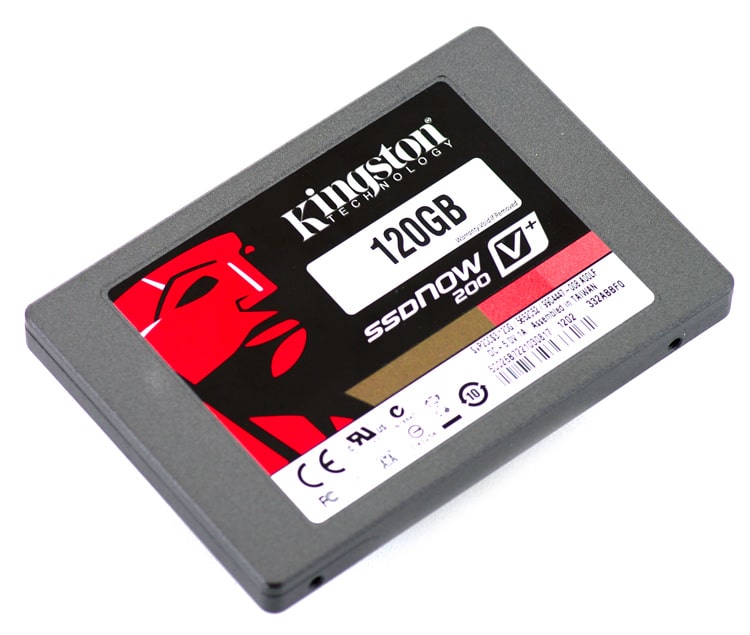
Kingston SSDNow V+200 Specs
- Capacities
- 60GB (SVP200S3/60G)
- Sequential Reads – 535 MB/s
- Sequential Writes – 460 MB/s
- Sustained Random 4k Read – 12,000/47,000 IOPS
- Max Random 4k Read – 85,000/60,000 IOPS
- 90GB (SVP200S3/90G)
- Sequential Reads – 535 MB/s
- Sequential Writes – 480 MB/s
- Sustained Random 4k Read – 20,000/47,000 IOPS
- Max Random 4k Read – 85,000/57,000 IOPS
- 120GB (SVP200S3/120G)
- Sequential Reads – 535 MB/s
- Sequential Writes – 480 MB/s
- Sustained Random 4k Read – 20,000/44,000 IOPS
- Max Random 4k Read – 85,000/55,000 IOPS
- 240GB (SVP200S3/240G)
- Sequential Reads – 535 MB/s
- Sequential Writes – 480 MB/s
- Sustained Random 4k Read – 36,000/43,000 IOPS
- Max Random 4k Read – 85,000/43,000 IOPS
- 480GB (SVP200S3/480G)
- Sequential Reads – 535 MB/s
- Sequential Writes – 480 MB/s
- Sustained Random 4k Read – 43,000/30,000 IOPS
- Max Random 4k Read – 75,000/34,000 IOPS
- 60GB (SVP200S3/60G)
- SandForce SF-2281 processor
- 25nm Asynchronous Intel MLC NAND
- Form factor: 2.5”
- Interface: SATA Rev 3.0 (6Gb/s)
- Three-year warranty with free 24/7 support
- Power Consumption: 0.565 W (TYP) Idle / 1.795 W (TYP) Read / 3.230 W (TYP) Write
- Storage Temperature: -40°C ~ 85°C
- Operating Temperature: 0°C ~ 70°C
- Dimensions: 69.85 x 100 x 9.5mm
- Weight: 115 grams
- Vibration Operating: 2.17G
- Vibration Non-Operating: 20G
- MTBF: 1,000,000 Hrs
Aesthetics
The Kingston SSDNow V+200 has a metal alloy case split between two halves connected with screws. The case has a bit of heft to it compared to other SSDs we have reviewed, with a very sturdy feel. The V+200 has a single drive sticker on the top, showing the drive information, including model, firmware revision, and serial number amongst other things.

The side profile of the SSD shows the seam where the top and bottom case segments meet and align for a precise fit in any 2.5-inch drive enclosure.

The front of the drive has a standard SATA data and power interface, with service pins next to it.
Disassembly
The SSDNow V+200 is simple to take apart, if you have a security Torx bit. While most other SSD manufacturers opt for using standard Phillips head or Torx screws, Kingston went a non-tamper route to further limit users from opening the drive. Considering there is a warranty void if removed sticker on the back and no user-serviceable parts inside, there is really no reason why anyone should need to open up the case during the use of this SSD.
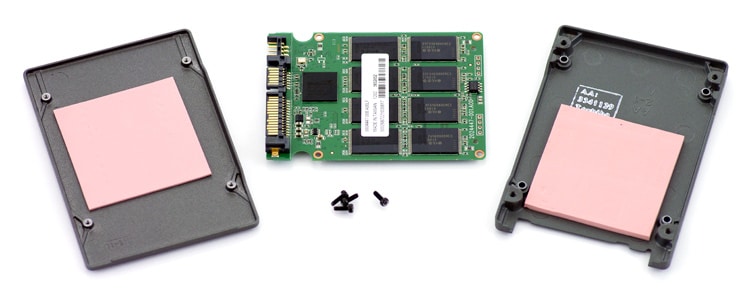
Inside we see that Kingston continues the tradition of using thermal pads above and below the circuit board to draw heat away from components such as the SandForce SF-2200 controller and Intel NAND. This is rather unique, as few SSD manufacturers go this route for drives that are designed for PC/workstation use. Good thermals are important though, especially if an SSD is going to be pressed hard, so while a seemingly small design feature, for heavy use this is a critical addition.
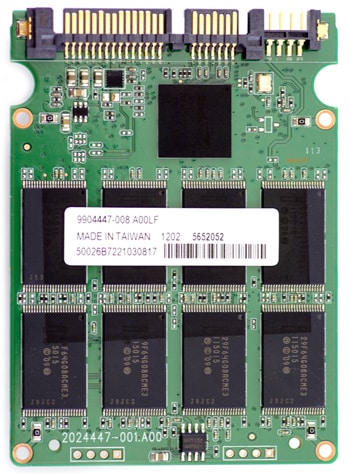
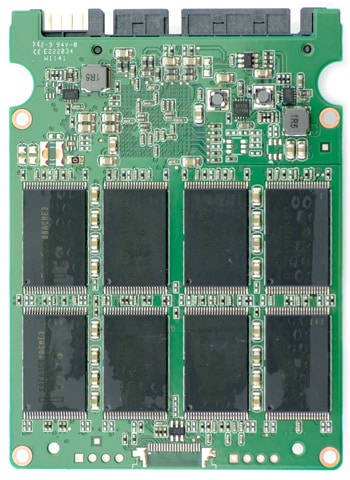
The Kingston SSDNow V+200 is powered by a SandForce SF-2281 processor, connected to sixteen 8GB Intel Asynchronous NAND pieces. They are divided evenly on both sides of the circuit board, with eight on top and eight on the bottom.
Synthetic Benchmarks
The Kingston SSDNow V+200 uses Intel 25nm asynchronous MLC NAND, a SandForce SF-2281 processor and SATA 6Gb/s interface; our review unit is the 120GB capacity. The comparables used in this review include the following SSDs: Intel SSD 520 (240GB, SF-2281, 25nm Synchronous NAND), OCZ Agility 3 (240GB, SF-2281, 25nm Asynchronous NAND), OCZ Octane (128GB, Indilinx Everest, 25nm Synchronous NAND) and the Corsair Force Series 3 (120GB, SF-2281, 25nm Asynchronous NAND). All drives are tested on the StorageReview client testing platform.
For the 120GB SSDNow V+200 capacity, Kingston lists a peak read speed of 535MB/s and a write speed of 480MB/s. To put these claims to the test, we used our 2MB sequential transfer test in IOMeter.
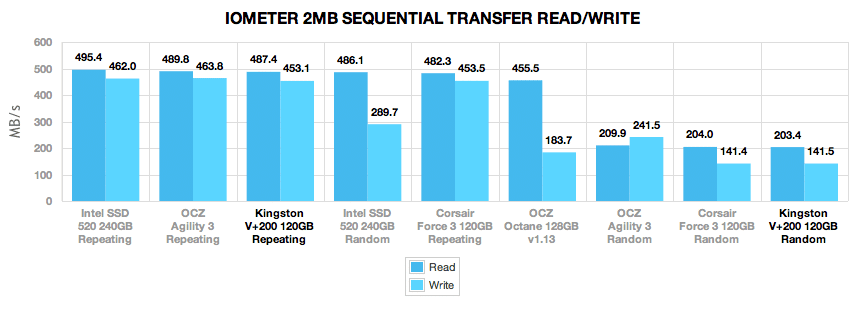
We measured 487.4MB/s read and 453.1MB/s write with repeating data, slowing to 203.4MB/s read and 141.5MB/s write with incompressible data in our sequential transfer test.
Our next test looks at random 2MB transfers instead of sequential, showing what performance might look like during multiple file transfer requests.
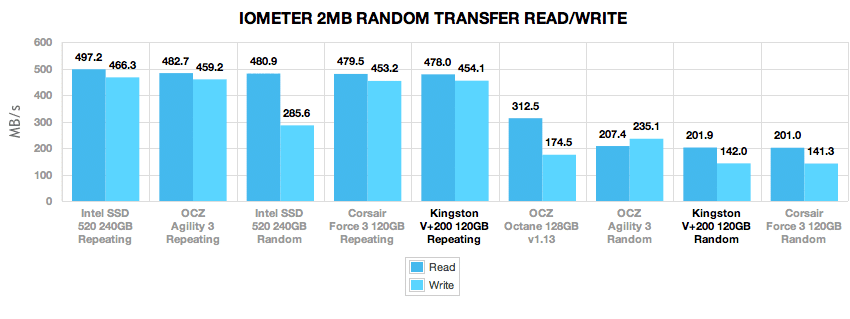
In the random large-block transfer test the Kingston V+200 measured 478MB/s read and 454.1MB/s write with compressible data and 201.9MB/s read and 142MB/s write with incompressible data.
Moving on to even smaller transfer request sizes, our next section looks at random 4K read and write performance at a queue depth of one, and later moves to expanded queue depth tests.
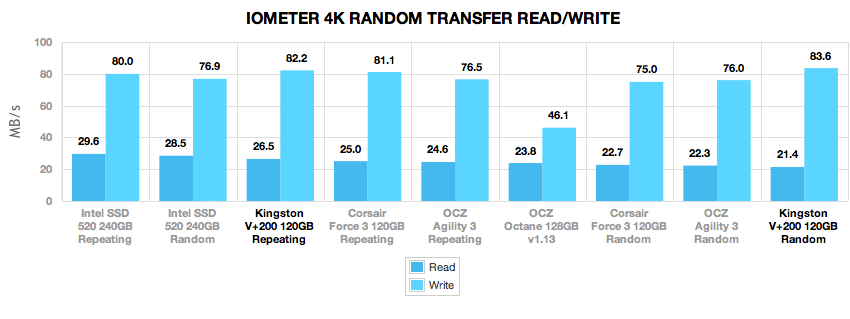
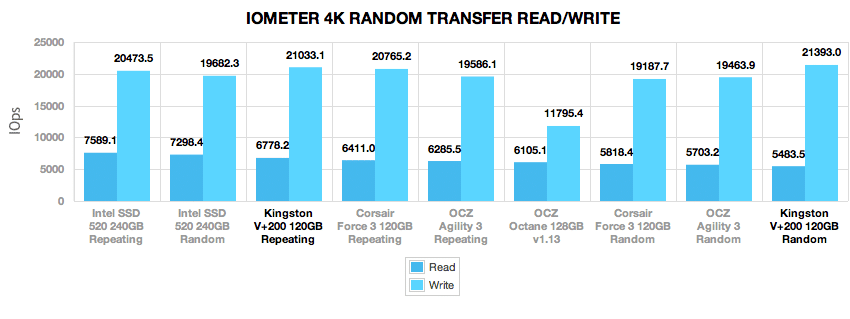
At a low queue depth the Kingston SSDNow V+200 ranked toward the top of the pack in 4K read speed, and topped the chart with its high 4K write speed with incompressible data.
In our expanded 4K random read and write tests, we look how well each drive performed with multithreaded access.
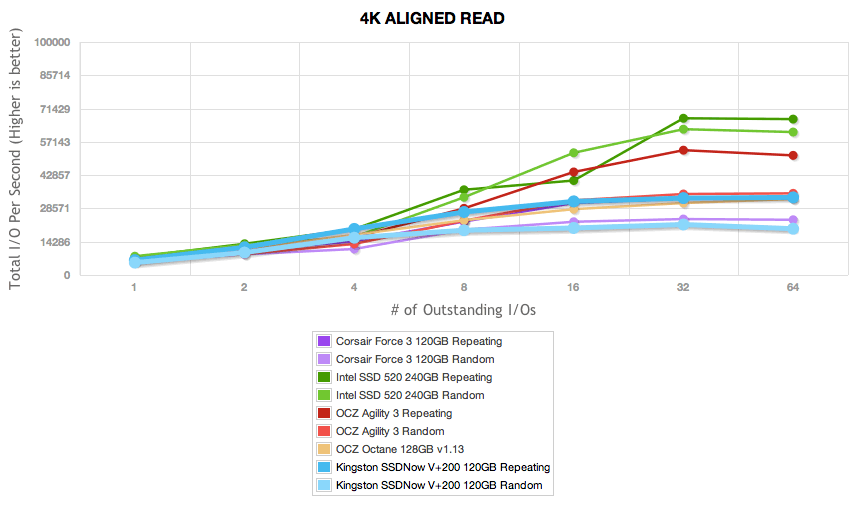
At higher queue depths the Kingston SSDNow V+200 fell back compared to higher capacity models topping at 33,300 IOPS read with compressible data. This slowed to 19,800 IOPS with randomized data.
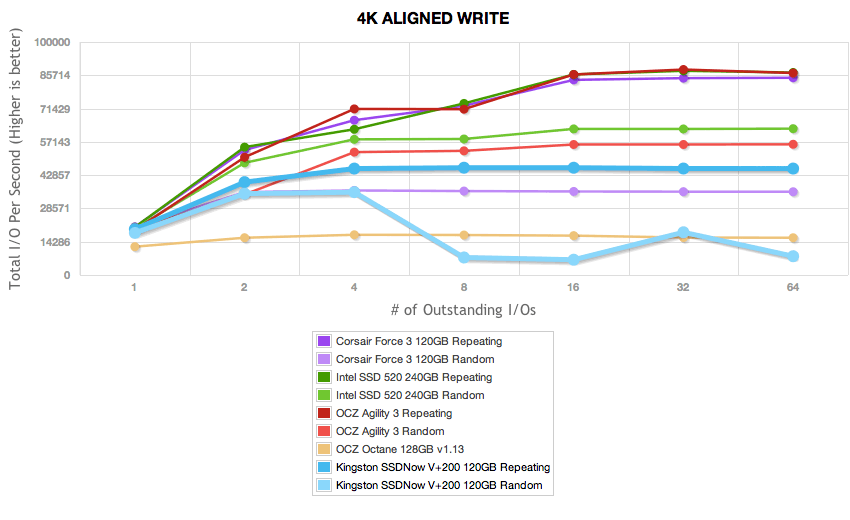
The Kingston V+200 ranked middle of the pack with 4K write speeds topping at 45,600 IOPS with compressible data and quickly peaking at 35,500 IOPS with incompressible data (but slowing down as the test continued).
In our 4K write latency test, which measures access times at a queue depth of 1, the Kingston SSDNow V+200 scored very well with average response times of 0.0463ms with incompressible data and 0.0471ms with compressible data. Peak latency times were also excellent, measuring 43.25ms and 41.04ms for repeating and randomized respectively.
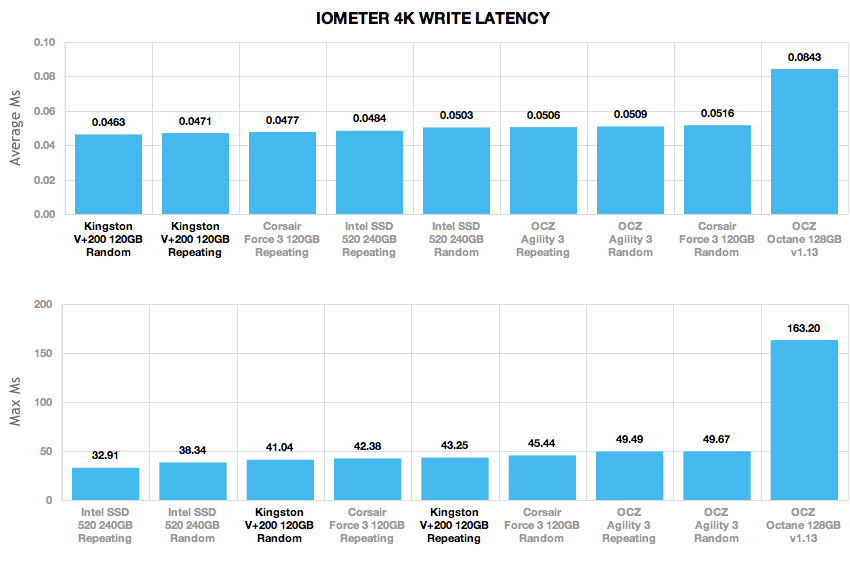
Using CrystalDiskMark with randomized data, we noted similar read and write speeds as what we found with our incompressible IOMeter testing, although CDM did give slightly higher read speed figures.
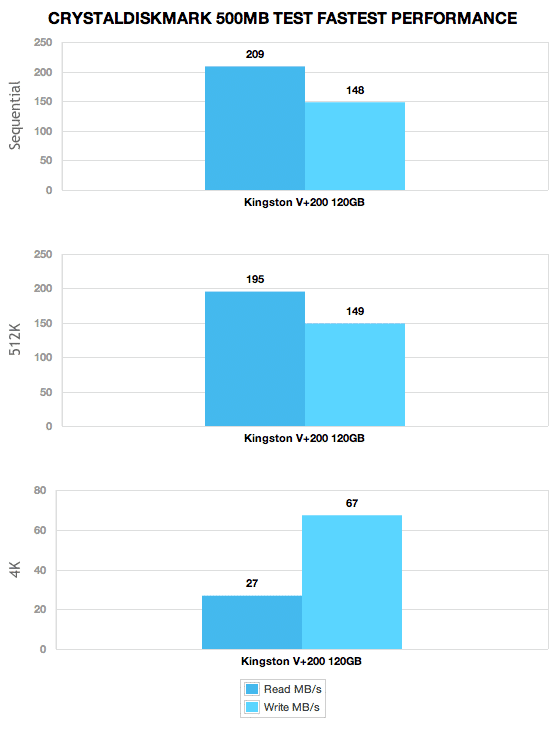
Our last group of consumer IOMeter synthetic benchmarks looks at mixed-load server profiles including Database, Workstation, File Server, and Webserver. In this group of tests the Kingston V+200 stayed towards the bottom of the pack, showing stronger performance with low-queue depth speed.
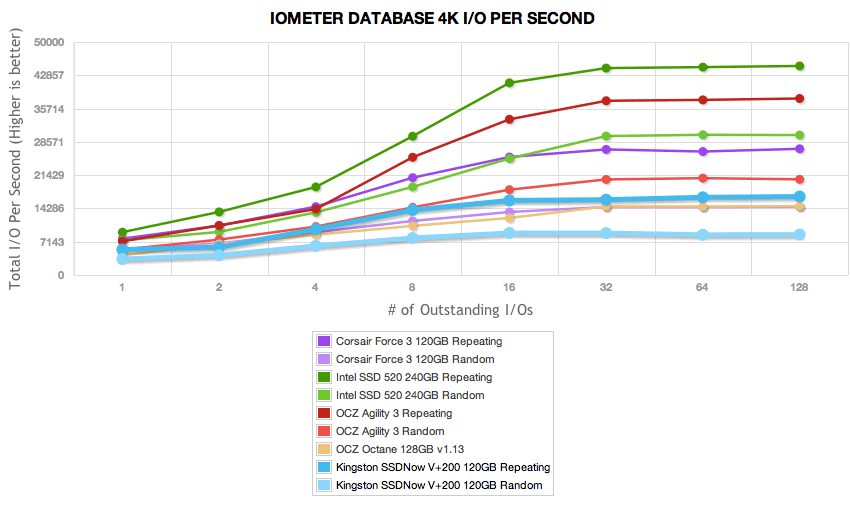
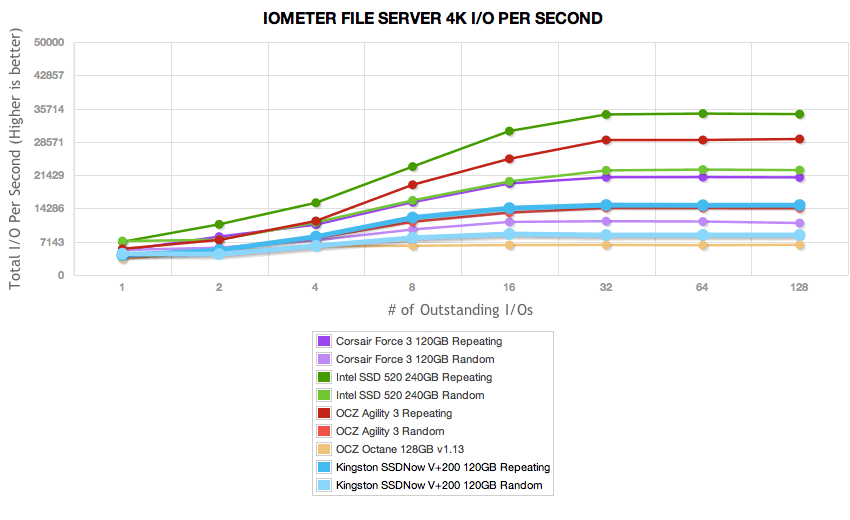
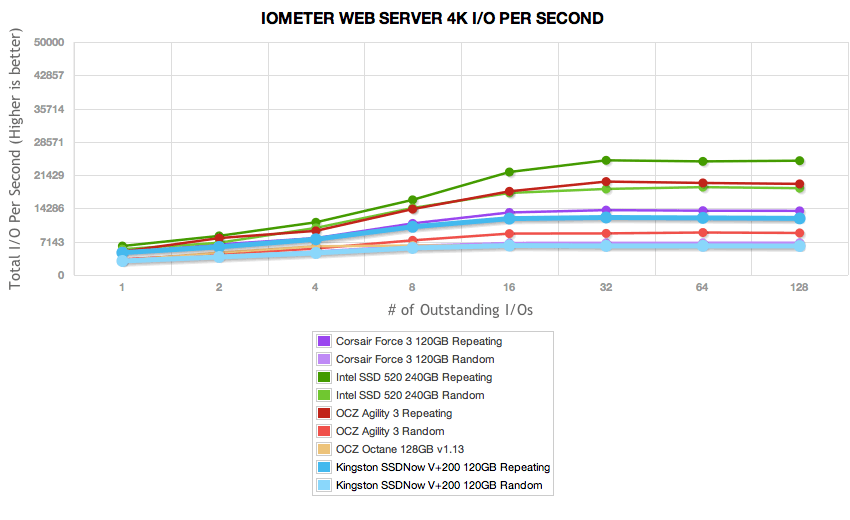
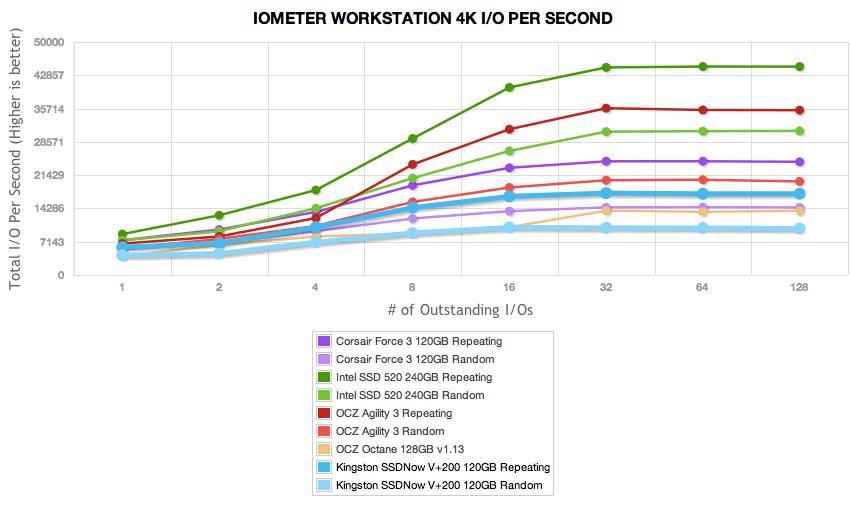
Real-World Benchmarks
One thing we try to focus on with our reviews is how any given drive might perform under real-world conditions. For the average user, trying to translate random 4K write speeds into an everyday situation can be difficult. It helps when comparing drives in every setting possible, but it doesn’t exactly work out into faster everyday usage or better game loading times. For this reason we turned to our StorageMark 2010 traces, which include HTPC, Productivity, and Gaming traces to help readers find out how a drive might rank under their conditions.
The first real-life test is our HTPC scenario. In this test we include: playing one 720P HD movie in Media Player Classic, one 480P SD movie playing in VLC, three movies downloading simultaneously through iTunes, and one 1080i HDTV stream being recorded through Windows Media Center over a 15 minute period. Higher IOps and MB/s rates with lower latency times are preferred. In this trace we recorded 2,986MB being written to the drive and 1,924MB being read.
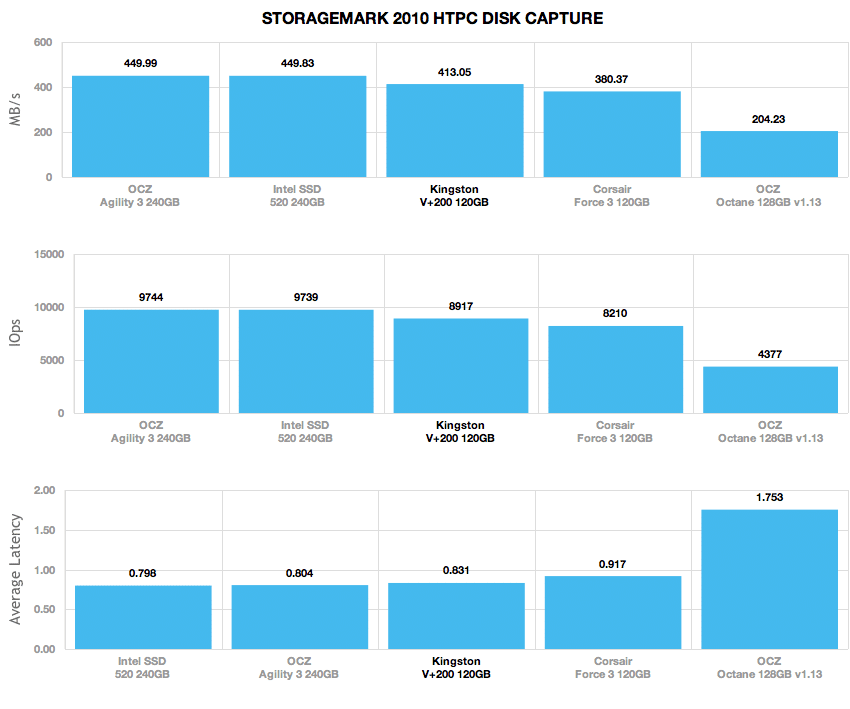
The Kingston SSDNow V+200 scored very well in our HTPC trace, coming in ahead of the Corsair Force 3 of the same capacity and configuration with a speed of 413MB/s and 8,917 IOPS average.
Our second real-life test covers disk activity in a productivity scenario. For all intents and purposes this test shows drive performance under normal daily activity for most users. This test includes: a three hour period operating in an office productivity environment with 32-bit Vista running Outlook 2007 connected to an Exchange server, web browsing using Chrome and IE8, editing files within Office 2007, viewing PDFs in Adobe Reader, and an hour of local music playback with two hours of additional online music via Pandora. In this trace we recorded 4,830MB being written to the drive and 2,758MB being read.

In our productivity trace the V+200 scored very well again compared to the 120GB Force 3, measuring 235MB/s average compared to 147MB/s of the Force 3.
Our third real-life test covers disk activity in a gaming environment. Unlike the HTPC or Productivity trace, this one relies heavily on the read performance of a drive. To give a simple breakdown of read/write percentages, the HTPC test is 64% write, 36% read, the Productivity test is 59% write and 41% read, while the gaming trace is 6% write and 94% read. The test consists of a Windows 7 Ultimate 64-bit system pre-configured with Steam, with Grand Theft Auto 4, Left 4 Dead 2, and Mass Effect 2 already downloaded and installed. The trace captures the heavy read activity of each game loading from the start, as well as textures as the game progresses. In this trace we recorded 426MB being written to the drive and 7,235MB being read.
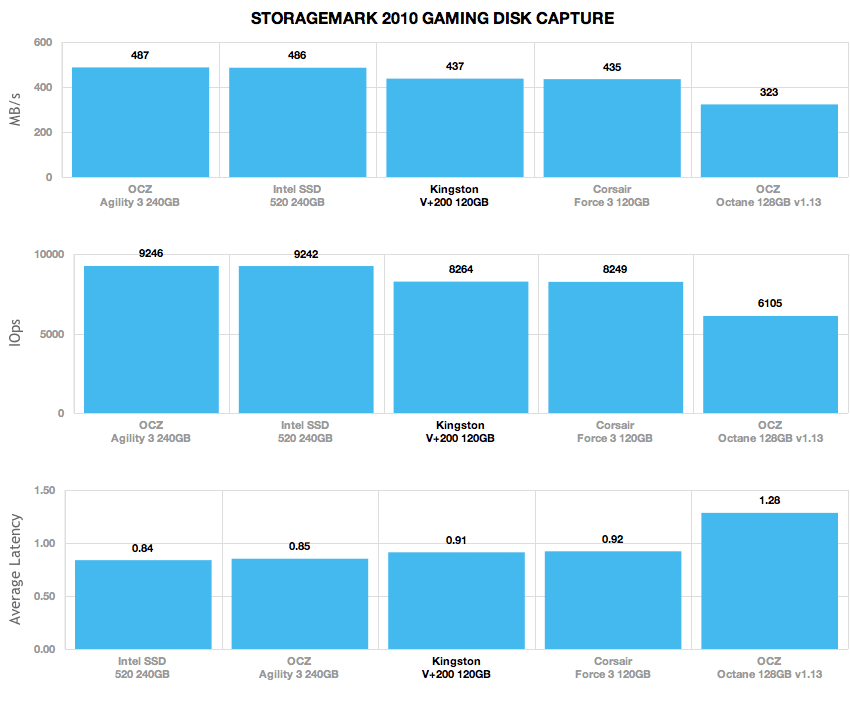
In our read-intensive Gaming scenario the Kingston V+200 and Corsair Force 3 both scored roughly the same speed, coming in at 437 and 435MB/s respectively.
Power
Applying the same read and write profiles that we performed at the beginning of this review, we measure the power used by the SSD during these read or write profiles. SandForce SSDs heavily rely on compression for faster speeds and less write amplification, as a result we measure power with both compressible and incompressible data.

Kingston claims a typical idle power value of 0.565 watts, with read activity measuring 1.795 watts and write activity measuring 3.230 watts. In our tests we measured an average idle power value of 0.48 watts, with a peak incompressible write power usage of 2.5 watts and a peak read usage of 1.4 watts.
Conclusion
The Kingston SSDNow V+200 fills an important gap in their SSD portfolio. While targeted toward end users within the enterprise, the V+200 will find itself widely adopted by consumers as well. Kingston has an offering targeted toward mainstream consumers in the SSDNow V200, but it’s performance is middling and it’s at price parity with the generally more robust V+200. Kingston of course is expecting traction with end users as well though since they offer an easy upgrade kit as an option for $15, something that appeals more to the client user than enterprise.
Regardless of the target, the V+200 holds up exactly as we’d expect for a SandForce enabled drive with asynchronous NAND. It’s in-line with the competitors, only falling down in some areas due to the 120GB NAND configuration. We were pleased with its performance, although in some business or enterprise-targeted benchmarks it did slip behind compared to similar drives. For end users though, the SSDNow V+200 packs a punch with strong low queue-depth performance with above average consideration for thermal dissipation under heavy workloads.
Pros
- Solid performance
- Smart case design with consideration for thermal dissipation
- Great low-queue depth 4K random write speed
Cons
- Slipped behind other 120-128GB SSDs in business workloads
Bottom Line
For buyers looking for a mainstream SSD with good performance and value, the Kingston V+200 is a solid option with extra attention paid to thermals. Upgraders should definitely take advantage of the upgrade kit, a tremendous value with only a $15 premium.
